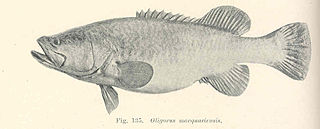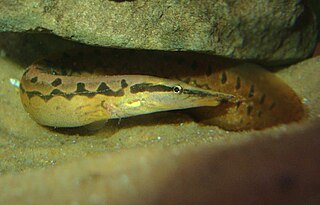
Crayfish are freshwater crustaceans belonging to the clade Astacidea, which also contains lobsters. In some locations, they are also known as baybugs, crabfish, crawfish, crawdaddies, crawdads, freshwater lobsters, mountain lobsters, mudbugs, rock lobsters, signal crawfish, or yabbies. Taxonomically, they are members of the superfamilies Astacoidea and Parastacoidea. They breathe through feather-like gills. Some species are found in brooks and streams, where fresh water is running, while others thrive in swamps, ditches, and paddy fields. Most crayfish cannot tolerate polluted water, although some species, such as Procambarus clarkii, are hardier. Crayfish feed on animals and plants, either living or decomposing, and detritus.

The trout cod or bluenose cod, is a large predatory freshwater fish of the genus Maccullochella and the family Percichthyidae, closely related to the Murray cod. It was originally widespread in the south-east corner of the Murray-Darling river system in Australia, but is now an endangered species.

The Macquarie perch is an Australian native freshwater fish of the Murray-Darling river system. It is a member of the family Percichthyidae and is closely related to the golden perch.

The river blackfish is a freshwater fish endemic to the temperate waters of south-eastern Australia. It is found from southern Queensland through to central Victoria, including in the Murray-Darling river system. It is also found in some eastern and southern flowing coastal rivers. Found primarily in upland and "midland" habitats, though early records of fish fauna suggest it was originally far more extensively distributed and was found in some lowland habitats as well. Originally, river blackfish co-inhabited many of its lowland and "midland" habitats with species such as Murray cod and golden perch, and its upland habitats with species such as trout cod and Macquarie perch. It is a popular angling fish in some parts of its range.

The two-spined blackfish is a species of temperate perch endemic to Australia.

The common yabby is an Australian freshwater crustacean in the Parastacidae family. It is listed as a vulnerable species of crayfish by the International Union for Conservation of Nature (IUCN), though wild yabby populations remain strong, and have expanded into new habitats created by reservoirs and farm dams.

The Tasmanian giant freshwater crayfish, also called Tasmanian giant freshwater lobster, is the largest freshwater invertebrate and the largest freshwater crayfish species in the world. The species is only found in the rivers below 400 metres (1,300 ft) above sea level in northern Tasmania, an island-state of Australia. It is listed as an endangered species on the IUCN Red List due to overfishing and habitat degradation, and it has been prohibited to catch the crayfish since 1998.

The silver perch is a medium-sized freshwater fish of the family Terapontidae endemic to the Murray-Darling river system in south-eastern Australia.

The leopard darter is a species of freshwater ray-finned fish, a darter from the subfamily Etheostomatinae, part of the family Percidae, which also contains the perches, ruffes and pikeperches. It is native to the United States, where it can be found only in the Little River drainage in Oklahoma and Arkansas. Its typical habitat is medium to large streams with rubble and boulder substrate. It feeds on small invertebrates on the riverbed and spawns mainly in March and April. It is threatened by impoundment, habitat loss and runoff from agricultural activities. It has never been a common species and has been listed as a threatened species in the United States since 1978, and the International Union for Conservation of Nature lists it as a "vulnerable species".

Euastacus is a genus of freshwater crayfish known as "spiny crayfish". They are found in the south-east of the Australian mainland, along with another genus of crayfish, Cherax. Both genera are members of the family Parastacidae, a family of freshwater crayfish restricted to the Southern Hemisphere.

The zig-zag eel, also known as the tire-track eel, tire-track spiny eel or marbled spiny eel, is a species of ray-finned, spiny eels belonging to the genus Mastacembelus of the family Mastacembelidae, and is native to the riverine fauna of India, Bangladesh, Pakistan, Sri Lanka, Thailand, Vietnam, Indonesia and other parts of Southeast Asia. The species was described as Macrognathus armatus by Lacepède in 1800. Other common names for this popular aquarium species are leopard spiny eel and white-spotted spiny eel. This species is not only a popular aquarium fish but also as a food fish in its country of origin.

Austropotamobius torrentium, also called the stone crayfish, is a European species of freshwater crayfish in the family Astacidae. It is mostly found in tributaries of the Danube, having originated in the northern part of the Balkan Peninsula.

Euastacus sulcatus, also known as the Lamington crayfish, is a freshwater crayfish, or "yabby", native to Australia. It is commonly bright blue in colour although also existing in a red and white, rusty red, brown, green, orange and completely white variations are found all around its known region. They can be found roaming the forest floor when conditions are damp, usually after substantial rainfall. Actively searching for a mate, new territory or food. When threatened, it raises its front two powerful pincers and will readily pinch any potential predator. The spiny crayfish has zero native predators by the time it reaches full-size maturity, although since the introduction of feral animals such as foxes and cats, it has suffered from predation not evolved to defend itself against. Due it its magnificent coloration it has also been targeted as a aquarium pet or even winding up on barbecues. This species is listed as protected and is an offence to trap/remove or harm this species, with on-the-spot fines of up to $522.

Euastacus spinifer is a species of freshwater crayfish endemic to Australia that belongs to the family Parastacidae.

The southern pygmy perch, also known as the Tasmanian pygmy perch, is a species of freshwater ray-finned fish, a temperate perch from the family Percichthyidae which is native to southeastern Australia and Tasmania.
Euastacus guruhgi is a species of freshwater crayfish found in the Australian state of New South Wales. It has an estimated extent of occurrence of 80 square kilometres (31 sq mi) and an area of occupancy of 7.5 square kilometres (2.9 sq mi) where it occurs fragmentedly. The species has been assessed as a critically endangered species due to a continuing decline in the quality of its habitat due to the invasive exotic species in the area, some of which predate upon this species. Furthermore, there is a continual destruction of its suitable rainforest habitat. E. guruhgi also faces the consequences of global warming; as a restricted range species, it is dependent on cool headwater streams and a slight increase in the temperature of the water could rapidly eradicate the species. There are no specific conservation measures for this species in place but the distribution range of the E. guruhgi falls within the Mount Warning and Wollumbin national parks. In New South Wales, there is a minimum recreational size limit of 90 mm orbital carpace length for any spiny crayfish. E. guruhgi does not attain that size, and is thus, indirectly protected by this restriction.
Euastacus dalagarbe is a species of freshwater crayfish endemic to Australia that belongs to the family Parastacidae. It has a small range in New South Wales and is regarded by the International Union for Conservation of Nature as "critically endangered".
Galaxias terenasus, the roundsnout galaxias, is a galaxiid of the genus Galaxias, a member of the Mountain Galaxias species complex group of freshwater fish, found in Australia.
Euastacus bidawalus, the East Gippsland spiny crayfish, is an Australian freshwater crayfish endemic to the East Gippsland area of Victoria and the far south coast of New South Wales.

Euastacus yanga, also known as the variable spiny cray, is a freshwater crayfish endemic to south eastern Australia.
















